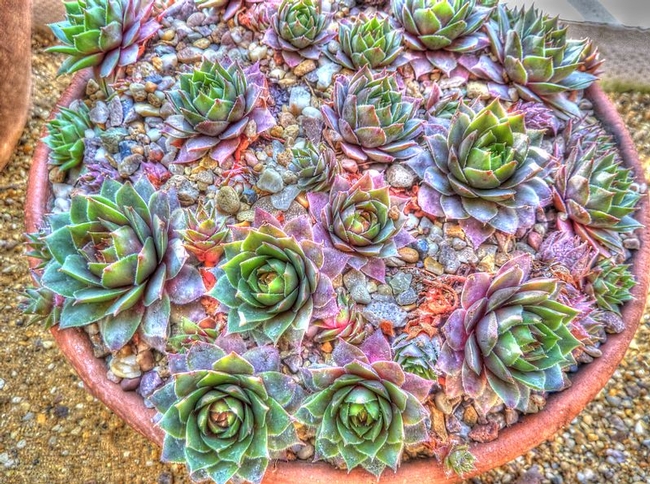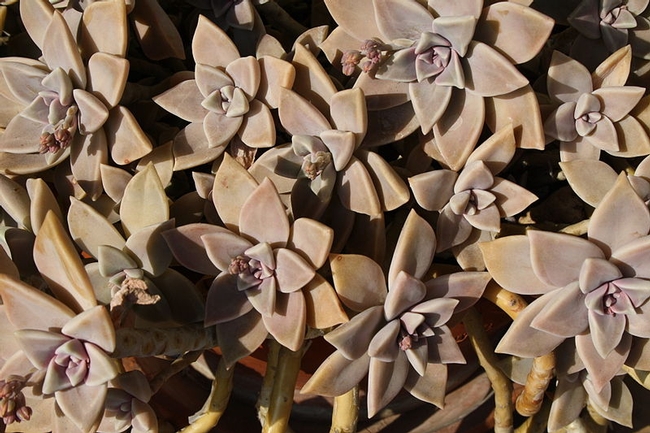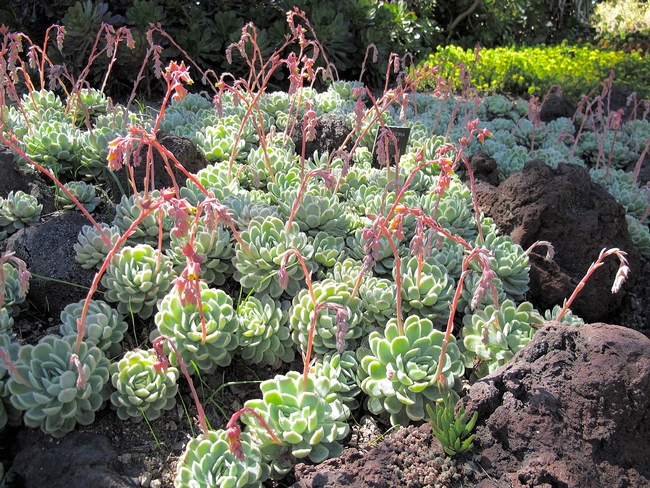By Barbara Ott, Butte County Master Gardener, February 17, 2017.
The current emphasis on water-wise gardening has created an interest in succulents. All succulents are able to store water and food in their leaves, stems and roots. These stored nutrients can be released when needed. This makes them drought tolerant. Succulents require good drainage, deep but intermittent water, bright light, and good air circulation. The soil should be open and airy with low organic matter.
Many gardeners grow succulents in the Crassulaceae family. Among the most popular are Echeveria, Graptopetalum, Aeonium, and Sempervivum. Echeveria, Graptopetalum, and Aeonium are hardy to USDA zones 9-12 (Or Sunset zones 8, 9, 12-24); while the hardier Sempervivum can thrive in a broader range, down to zone 5 (or Sunset zones 2-24, according to the Sunset Western Garden Book).
Because many purchased succulents are unmarked, while others are given by friends as cuttings, it can be difficult to know the genus of a particular plant. This is especially the case because the genera of Echeveria, Sempervivum, and Graptopetalum are similar in appearance. However, careful observation will aid in identifying succulents. First, look to see if the succulent is spiky or chubby, and whether it forms rosettes. What is the shape of the leaves? Look at size, texture, and color. Notice if offsets hang from the edges of a rosette, or attach to its center.

Echeverias are valued for their colors and variations. Native to the Americas, their rosettes range in size from three-quarters of an inch to 20 inches in diameter. Echeverias have thicker and wider leaves than Sempervivums. While both include varieties commonly called “hens and chicks” they are from different genera. The leaves of Echeveria are spoon-shaped, and gray, green or bluish in color. These plants flower in the warmer months. Their bell shaped flowers appear on stalks that rise up through the leaves, and can be white, orange, pink, or red. Echeveria offsets (chicks) grow out from a single base stem and form clumps.
Sempervivums are native to Europe. Their value as talismans is reflected in their name semper (always) and vivus (living). This reputation comes from their ability to survive in freezing weather while their leaves stay green. Sempervivums are commonly called Houseleeks or Hen and Chickens. Open rosettes range from one to five inches across and form clumps to two feet or wider. The leaves of Sempervivum are narrower than those of Echeveria, they have pointy tips, andaregray-green to red-brown in color. Small, pink, red, or orange star-shaped flowers arise on fleshy stems to 10 inches tall. These succulents reproduce from offsets attached to a stolon (a stem that can take root).The stolon breaks easily, allowing the tiny offsets to roll away before forming roots.

When looking at “mystery” succulents think in terms of leaf shape, color, and thickness. Then look to see if there are offsets. Are the offsets located on stolons or attached to a main stem? Watch for flowers and see if they are bell shaped or star shaped. All of these characteristics will provide information about the genus of the “mystery” succulent.
Photo credits: Wikipedia Commons
Table for identifying Echeveria, Sempervivum, and Graptopetalum:
|
Characteristics of common varieties |
Echeveria |
Sempervivum |
Graptopetalum |
|
Origin |
North & South America |
Europe |
South America |
|
Rosette size |
3/4”-20” diameter |
1”-5” diameter |
2”-5” diameter |
|
Offset Spread |
spread from a main stem |
clumping, stolon held |
rosettes break off from root |
|
Leaves |
thick & spoon-like |
narrow & pointy |
thickest & rounded |
|
Leaf color |
gray-green, bluish |
gray-green, red-brown |
chalky gold or green |
|
Flower shape |
bell shaped |
star shaped |
star shaped |
|
Flower color |
white, orange, pink, red |
red, yellow, pink |
white/red, yellow |
|
Flower growth pattern |
on stem amidst leaves |
on stolon from center |
stem from center |
|
Common name |
Hen & Chicks |
Hen & Chicks |
Ghost plant |
Table created by Barbara Ott



